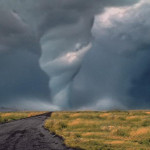Created by: Silentchapel
Number of Blossarys: 95
Tornadogenesis is the process by which a tornado forms. There are many types of tornadoes, and each type of tornado can have several different methods of formation. Scientific study is ongoing, as ...
A tornado family is a series of tornadoes spawned by the same supercell thunderstorm. These families form a line of successive or parallel tornado paths and can cover a short span or a vast distance. ...
A tornado outbreak is the occurrence of multiple tornadoes spawned by the same synoptic scale weather system. The number of tornadoes required to qualify as an outbreak typically are at least six to ...
A multiple-vortex tornado is a tornado that contains several vortices rotating around, inside of, and as part of the main vortex. The only times multiple vortices may be visible are when the tornado ...
A funnel cloud (generally the cause of a twister or tornado) is a funnel-shaped cloud of condensed water droplets, associated with a rotating column of wind and extending from the base of a cloud ...
A waterspout is an intense columnar vortex (usually appearing as a funnel-shaped cloud) that occurs over a body of water, connected to a cumuliform cloud. Waterspouts do not suck up water; the water ...
A tornado is a violently rotating column of air that is in contact with both the surface of the earth and a cumulonimbus cloud or, in rare cases, the base of a cumulus cloud. Most tornadoes have wind ...


 English (EN)
English (EN)





